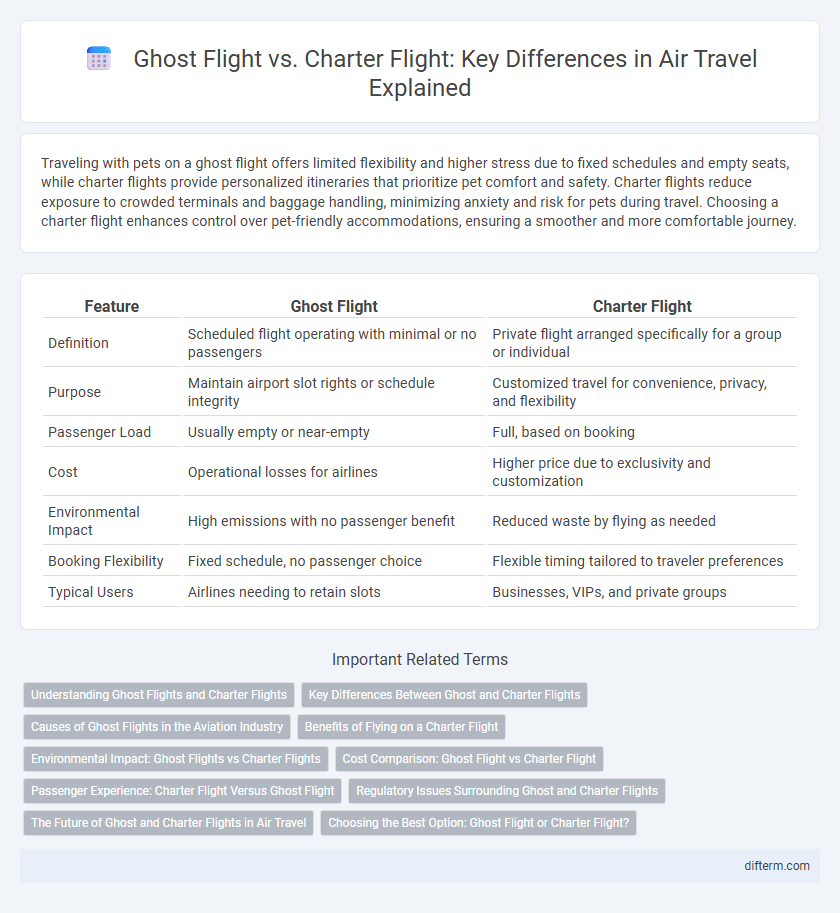Traveling with pets on a ghost flight offers limited flexibility and higher stress due to fixed schedules and empty seats, while charter flights provide personalized itineraries that prioritize pet comfort and safety. Charter flights reduce exposure to crowded terminals and baggage handling, minimizing anxiety and risk for pets during travel. Choosing a charter flight enhances control over pet-friendly accommodations, ensuring a smoother and more comfortable journey.
Table of Comparison
| Feature | Ghost Flight | Charter Flight |
|---|---|---|
| Definition | Scheduled flight operating with minimal or no passengers | Private flight arranged specifically for a group or individual |
| Purpose | Maintain airport slot rights or schedule integrity | Customized travel for convenience, privacy, and flexibility |
| Passenger Load | Usually empty or near-empty | Full, based on booking |
| Cost | Operational losses for airlines | Higher price due to exclusivity and customization |
| Environmental Impact | High emissions with no passenger benefit | Reduced waste by flying as needed |
| Booking Flexibility | Fixed schedule, no passenger choice | Flexible timing tailored to traveler preferences |
| Typical Users | Airlines needing to retain slots | Businesses, VIPs, and private groups |
Understanding Ghost Flights and Charter Flights
Ghost flights are commercial airline flights operating with minimal or no passengers, primarily to maintain airport slots and schedules, resulting in significant environmental and financial costs. Charter flights are privately booked aircraft tailored for specific groups or purposes, offering flexible routes, schedules, and often enhanced privacy. Understanding the stark differences helps travelers make informed decisions based on cost, convenience, and environmental impact.
Key Differences Between Ghost and Charter Flights
Ghost flights operate without passengers, primarily to maintain airport slots, while charter flights are privately booked for specific groups or purposes. Ghost flights often result in fuel waste and increased emissions, whereas charter flights provide flexible schedules and direct routes tailored to travelers' needs. Unlike ghost flights, charter flights offer a personalized travel experience with control over destinations and timings.
Causes of Ghost Flights in the Aviation Industry
Ghost flights occur primarily due to regulatory requirements mandating airlines to operate minimum scheduled services to retain airport slots despite low passenger demand. These empty or near-empty flights prevent slot forfeiture during periods of reduced travel demand or operational constraints. Seasonal downturns, sudden travel restrictions, and airline operational strategies also contribute to the persistence of ghost flights in the aviation industry.
Benefits of Flying on a Charter Flight
Charter flights offer flexible scheduling and personalized itineraries, making them ideal for travelers seeking convenience and efficiency. These flights often provide direct routes to less accessible destinations, reducing travel time and layovers compared to ghost flights. Enhanced privacy and customized services on charter flights ensure a more comfortable and tailored travel experience for passengers.
Environmental Impact: Ghost Flights vs Charter Flights
Ghost flights generate unnecessary carbon emissions by flying empty or nearly empty aircraft to maintain slot allocations, significantly increasing aviation's environmental footprint. Charter flights, typically booked for specific groups and purposefully filled, offer a more efficient use of resources, thereby reducing per-passenger emissions compared to ghost flights. Reducing ghost flights can substantially lower carbon emissions and help airlines meet environmental sustainability goals.
Cost Comparison: Ghost Flight vs Charter Flight
Ghost flights incur high operational costs without passenger revenue, often resulting in significant financial losses for airlines due to fuel consumption, crew salaries, and maintenance for empty flights. Charter flights offer cost-efficiency by consolidating group travel, enabling passengers to share expenses and benefit from lower per-seat prices compared to regular commercial flights. Airlines and travelers seeking budget-friendly options typically prefer charter flights over ghost flights, as charters optimize resources and reduce unnecessary expenditures.
Passenger Experience: Charter Flight Versus Ghost Flight
Charter flights offer passengers a tailored travel experience with flexible schedules, personalized services, and often enhanced comfort levels compared to commercial flights. Ghost flights, operating with minimal or no passengers, lack the typical in-flight amenities and the social atmosphere that result in a more isolated and less engaging journey. Choosing a charter flight ensures improved passenger satisfaction through direct routes and customized onboard environments, unlike ghost flights that primarily serve operational or regulatory purposes.
Regulatory Issues Surrounding Ghost and Charter Flights
Ghost flights, operating without passengers primarily to maintain airport slots, face increasing scrutiny due to environmental regulations and slot usage rules enforced by aviation authorities like the European Union Aviation Safety Agency (EASA). Charter flights, while subject to standard safety and operational regulations from governing bodies such as the Federal Aviation Administration (FAA), typically avoid the regulatory complications linked to slot preservation. Regulatory frameworks emphasize reducing unnecessary emissions, prompting stricter oversight and potential penalties on airlines running ghost flights compared to more flexible charter flight operations.
The Future of Ghost and Charter Flights in Air Travel
The future of ghost flights and charter flights in air travel hinges on evolving industry demands and sustainability goals, with ghost flights expected to decline due to environmental regulations and growing pressure to reduce carbon emissions. Charter flights will likely expand, driven by increasing demand for personalized travel experiences, flexibility, and direct routes not covered by commercial airlines. Technological advancements and digital booking platforms will further enhance the operational efficiency and accessibility of charter flights, positioning them as a vital component in the future air travel landscape.
Choosing the Best Option: Ghost Flight or Charter Flight?
When choosing between a ghost flight and a charter flight, prioritize your travel needs such as flexibility, privacy, and cost. Charter flights offer personalized schedules and destinations with higher privacy, ideal for business or group travel, while ghost flights, often operating with empty seats to maintain operational slots, provide less convenience and can be environmentally unfriendly. Assessing factors like budget, time constraints, and environmental impact will help determine the best option for your specific travel itinerary.
Ghost Flight vs Charter Flight Infographic

 difterm.com
difterm.com